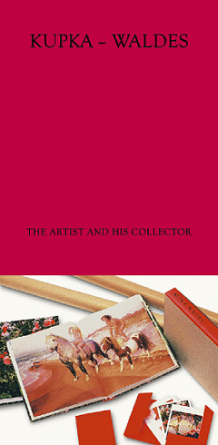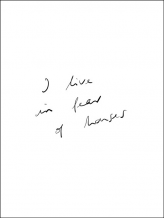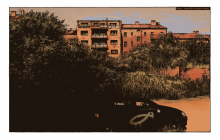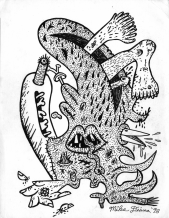| Zeitschrift Umělec 2002/4 >> Art of graffiti — Prague style (interview with JanKaláb) | Übersicht aller Ausgaben | ||||||||||||
|
|||||||||||||
Art of graffiti — Prague style (interview with JanKaláb)Zeitschrift Umělec 2002/401.04.2002 Tony Ozuna | graffity | en cs |
|||||||||||||
|
Artist Claes Oldenburg said it nicely: “You’re standing there in the station, everything is gray and gloomy, and all of a sudden one of those graffiti trains slides in and brightens up the place like a big bouquet from Latin America.” Oldenburg was talking about New York City, of course.
In our case, the city is Prague: in a charmed, forgotten corner of Prague’s New Town, behind Charles Square, there were numerous times when I’d been caught off guard, always while walking up Na Zbořenci. More often than not it was a gloomy day, drizzling, when all of a sudden BOOM. It always hit me, surprised and reminded me at the same time. In every case it uplifted me for the rest of the afternoon. I’m referring to a three-walled mural, which no longer exists, called Jazzstyle Compilation by Jan Kaláb. So first of all, how did you obtain this cornered wall space in New Town? Yeah, a friend’s dad works in art, he has a gallery and a couple of buildings, and these buildings have large, bare walls. Last year I painted the space on the condition that in a year I would paint something else, over it. Actually, in Prague, there aren’t a lot of good walls. But this one’s great, not simple - there are three adjacent walls -actually there are six. And to say there’s eight would also be true. It’s in the center and at the same time hidden away. Where and who do you study with, if you are still a student? First I studied architecture with professor Jiřičen at UMPRUM. But after half a year I dropped out. Then I “studied” sculpture with professor Beránek also at UMPRUM, but then I transferred to AVU to the drawing studio of professor Svoboda. It’s interesting that you studied architecture first. Walls and their structure are obviously important for your work. Why did you transfer instead of trying to study at both schools? Graffiti relies on architecture, and this matters to me very much, so that my piece settles into the surroundings. But, you know, if you really want to do something, it doesn’t work to pursue too many things at once. Especially if you have to go to so many architecture lectures. Respect, but I gave it up. I won’t be so far from it, but at the same time not so bound to it. When I do something, it doesn’t have to have a social institution behind it and the toilet responds to some norms. And it’s always possible to collaborate with someone who knows what he’s doing, and when it’s necessary. Would you say that you do hip hop graffiti or murals? I paint murals, and classic hip hop graffiti. It depends. I also do three-dimensional graffiti. Are you only a graffiti artist or are you also a “tagger?” I was basically never a tagger. Of course I have made a few tags, but I don’t have it in my blood. And I am attracted to big walls. I enjoy going out on Saturday afternoons with friends to paint graffiti. I don’t paint trains anymore, but I used to be obsessed with this. How many trains would you say that you’ve “bombed” as a graffiti artist? I remember when Prague subway trains were also blooms of graffiti, constantly, every morning there were great new works. I loved seeing that, but I guess it’s just not possible now. Was it “dangerous” when you did trains? Altogether I’ve painted somewhere between 200-250 trains. Home and abroad. Of course I’ve had trouble with police because of this. But it was also fantastic. I’m too lazy now and it’s not worth it. It’s too stressful and psychotic for me. But to paint trains is true graffiti. Whoever’s never done it just can’t understand. What are your preferred materials? On walls I use a lot of latex colors, paint-rollers, sometimes brushes and of course spray. But recently I’ve been experimenting with other materials, like wood, metal, and plastic. How does it feel when you have to paint over a piece of your own? Especially something like Jazzstyle. The metro trains must have been a different story, because you knew that your art will only “live” for a few hours. What’s the difference when you have to paint over your own work yourself and when a transportation worker does it? When you paint a train, you do it knowing that, ideally, it will be seen for just a couple of runs. You can photograph it, and then it’s gone. In this case, you know the toll ahead of time. When you paint a wall, you can’t ever be sure that your piece will stay for a long time. And, like I said, there isn’t an infinite number of walls, so writers have to paint over pieces, your own or others. And that’s where the problem begins. In graffiti the community uses the word RESPECT. That means that you have the so-called right to go over only worse or older things. Graffiti is ephemeral, and I love this aspect. What’s most important is the process; with the result, you’re never going to be satisfied. For me it is a kind of mandala, it connects to how life is also ephemeral. And so actually it’s great to paint over your own work, certainly better than when someone else does it. I enjoy the pressure that I have to overcome. When I think about it, it doesn’t matter to me who paints over the work. The only thing that matters to me is that it is documented. Then the value of it stays there on the materials. And I’m no Tibetan monk. What’s the difference between permanent and impermanent art? It seems to me that when you make “impermanent” art, it forces you to keep making more. And you don’t have to figure out where you’re going to keep the stuff when nobody is interested in it anyway. It’s probably true that when you make something with the intention of it lasting for ages you’re more precise and you play more with the details. For the time being I don’t have the feeling that what I do is so good, that it has to be preserved for all time. I think it’s fine to do something that’s there for a few months, exhibit it, then throw it away, or put it somewhere and watch how it succumbs to time… When someone offers me millions, I’ll happily leave something behind for eternity. But I am not saying that I won’t change my mind in the future. I’m 24, and I hope that I still have the important work ahead of me. So what do “folks” do or say when they see you painting a wall in public? People need to speak. It’s always the same. When you’re doing an undercoat over some old graffiti, which they are used to seeing, they cuss you out because you’re doing this. When you are painting, then they ask, “so paint something that’s pretty!” And when you’re almost finished, then they ask “what is it?” It’s never happened that a great-looking girl would come up and say, “that’s so cool” and force me to take her phone number. So I just prefer listening to my walkman when I’m painting. Many people when they see graffiti in the street get angry. This is true everywhere, even in East Los Angeles, where I grew up. Why do you think this is? Yeah, people are mostly angry with taggers and “bombing,” and I think they have a right to be. They don’t know who is doing it — they don’t know why it appears. They don’t know how to decipher it, and no one asked them whether they like it or not. It just appears there where before there wasn’t this encroachment. The biggest problem is when they discover graffiti on their PRIVATE wall. Is there a “king” of graffiti in Prague? Someone that everyone follows or respect because of his style or because he was the first? No, I don’t think there is. We’re all like one group, we all know each other, everyone paints a little bit differently and different things, we respect each other and so on. Someone is always better or worse. But we’ve been playing like we were kings and rookies since we were 17. Now we don’t take it so seriously, we just like to spray walls. In Prague I most appreciate POISe. He paints classic graffiti, but with 100 percent style and out of all of us he’s been doing it the longest. You said that you listen to your walkman when you’re working. Were you listening to jazz when you made Jazz Style Compilation? I don’t really remember, but definitely more hip hop. I signed it Jazz Style mostly because it’s a name for new experimentation in graffiti. Friends in Berlin presented it as Jazz Style Corner. Nothing official, just said that way. Jazz is about improvisation. That’s how we paint too… Do you make graffiti only in Prague or also in other cities in the Czech Republic or abroad, like Berlin, for instance? For now the wall paintings, like the one on Na Zbořenci, I only do in Prague. After all, you only need a background. But there are pieces everywhere I go… Graffiti traveling. Do you think there’s a big difference between graffiti art in the West and in Central and Eastern Europe? Of course there is, just like there’s a difference in our mentality and lifestyles. In the last few years, it’s gotten especially interesting, because there’s more experimenting, and that’s why you can see greater differences. Actually, this depends on individuals. There are magazines, internet, so styles can have an influence very quickly. It’s all relative, and so I really don’t like to compare. But I think that the role that we are living in the former Eastern Bloc no longer applies. What do you mean that it doesn’t apply, if we are currently living in the former Eastern Bloc? I’m just no longer willing to feel like the poor relative. I remember when I was 20, I felt a little embarrassed when I had to tell someone that I was Czech. I had the feeling that I was out. I had the feeling that I was inferior. It seems to me that many young people think the same thing. Maybe I’m wrong. Everyone wants to be worldly and so on. But how would it sound in Brazil, for example, if you explained that you had to slave away far more than a German to buy your ticket and fly to Sao Paulo? Would what it mean to explain something about Eastern Europe to someone who’s never seen it, because he has to work seven times as much and he still thinks that Europe is one state? Being worldly doesn’t mean acting like an American, but rather to show your cards and play with what you have. And damn we’ve got it good here. And then I realized that I am proud that I come from this country, and the fact that I only vaguely remember communism is a big plus. As a graffiti artist, what do you think about the commercial by the National Gallery? [In the spot a sprayer copies a painting by František Kupka.] By coincidence I made that painting myself. And the two sprayers running away are my friends. Kupka is one of my favorite Czech artists and a few years ago I stood in front of one picture in the gallery (Energetic 2) and I said: “Holy shit, this is real graffiti.” Well, then a couple of years later the phone rings and they want me to paint graffiti-Kupka. I experienced something like a day with Kupka. I painted one of his paintings from a picture. I just wrote on the wall POINT. I preserved his form and colors, but the composition and content are mine. It wasn’t at all easy to orient myself within the painting… And of course you saw the commercial, and they don’t even know that they actually made a commercial for POINT… And they even paid me for it. Thanks! There are two more funny things. The people from the gallery shot the film on a tripod, but nobody — not even the people in the commercial — realized that it was upside down… (in the commercial it’s set right again). The second thing is that, in a country where graffiti is illegal, they shot a commercial about graffiti, and the director of the national gallery [Milan Knižák] agreed to it, even though he said he would cut off the hands of sprayers. And the third thing is what bothers me the most: The National Gallery owns no graffiti!
01.04.2002
Empfohlene Artikel
|
|||||||||||||
|
04.02.2020 10:17
Letošní 50. ročník Art Basel přilákal celkem 93 000 návštěvníků a sběratelů z 80 zemí světa. 290 prémiových galerií představilo umělecká díla od počátku 20. století až po současnost. Hlavní sektor přehlídky, tradičně v prvním patře výstavního prostoru, představil 232 předních galerií z celého světa nabízející umění nejvyšší kvality. Veletrh ukázal vzestupný trend prodeje prostřednictvím galerií jak soukromým sbírkám, tak i institucím. Kromě hlavního veletrhu stály za návštěvu i ty přidružené: Volta, Liste a Photo Basel, k tomu doprovodné programy a výstavy v místních institucích, které kvalitou daleko přesahují hranice města tj. Kunsthalle Basel, Kunstmuseum, Tinguely muzeum nebo Fondation Beyeler.
|



































 We Are Rising National Gallery For You! Go to Kyjov by Krásná Lípa no.37.
We Are Rising National Gallery For You! Go to Kyjov by Krásná Lípa no.37.
Kommentar
Der Artikel ist bisher nicht kommentiert wordenNeuen Kommentar einfügen